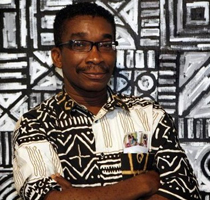I left Germany, a few weeks before the opening of the Who Knows Tomorrow show. Berlin was one of the cities I visited whilst in Germany. It was actually my first time in Germany. I had a wonderful time there. In fact, I was so well received, with open arms. The people were incredibly friendly, contrary to the perception I had prior to my arrival there. I was simply so fascinated and enchanted by the people, history and beauty of Germany I took tons and tons of pictures wherever I went to, which I liberally splashed on my page on Facebook, to share with my friends and all-and-sundry. I proudly named my albums containing my German pictures Germany 1, 2, 3, 4, 5… I am even yet to upload more pictures from my German visit. I did not have any fore-knowledge whatsoever of the up-coming Who Knows Tomorrow whilst in Berlin.
The artist is a universal being who speaks a universal language, which cuts across national and geographical barriers. The artist can simply be inspired by anything he encounters in his daily life – by sights, travel, or technology and so on – even if it is far removed from his national geographical origin. Jean Fisher puts it more succinctly: “Artists have always been magpies, alert to new visual strategies and aesthetic ideas, absorbing influences from whatever visual resources are available to them, and limited only by the horizon of knowledge, or the information flow of the society in which they are living. To deny an artist entitlement to this exchange is to imply cultural stagnation.”
My love with Germany, which makes me want to splash all those pictures I took on Facebook, does not mean I would be entering into any debate about my identity as an African artist in a globalized village. I am overly sure the same goes for El Anatsui. He was simply enamored with what he encountered whilst on the site visit. Everything could potentially be a stimulus to ignite an artist’s creative work. It’s is superfluous for Chike Okeke-Agulu to want to associate Anatsui with any identity debate. The former suggests that Anatsui’s photos of his visit to Germany is probably a coded rebuttal of those critics who celebrate Anatsui’s residency in Africa; the photos rather suggests that Anatsui is a citizen of the world.
Anatsui, to a large extent, has always engaged global issues – history, memory, consumerism, migration, transience and transformation – even though his work is wholly rooted in Africa, and is about Africa. He has always had a universal outlook on life, and that is the hallmark of any serious artist, and did not have to go to Germany, present photos of his site visit to Germany to “enter the debate about the identity of contemporary African artists”. He is reported to have once said: “I don’t see anything wrong with exposure [to Western ideas and forms]. In fact, nothing is wrong with it because if one really has a strong personality, the danger of it being eroded is not very strong. Absorb influences, but be yourself. The influence might rather make you stronger… So I don’t close my eyes to influences outside, whether African or European.”





No Comments so far ↓
There are no comments yet...Kick things off by filling out the form below.